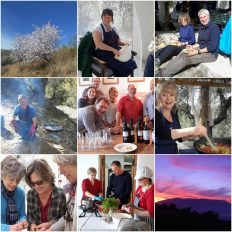Going up to the smoke (not up in smoke….)
Much as we love our base by the beautiful river Dart, it’s always good to get out and about and meet some new faces, especially when it comes to cooking. So it was in July we headed up to west London to talk about wood fired cooking with some members of the Guild of Food Writers. Fantastic to meet up with so many enthusiasts and experts in their field and to discuss food, wood fired cooking, what we do, what they do…… Using the Morso Forno, we made a few dishes to given them an idea of what the ovens could do.
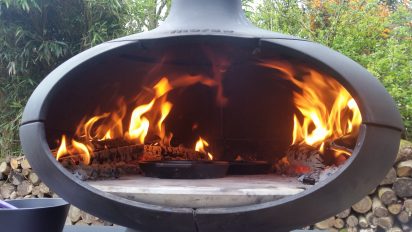
Here’s what we made –
| Foccaccia from our Wood Fired Flat Breads & Pancakes This is one of the most popular breads on our village bread box delivery and known in some friends’ house by the kids as David’s bread; the dough is a bit challenging to make as it’s so soft but it forms an incredible big pillow that gives a satisfying wobble when patted and you can just imagine sinking into it for an afternoon nap; well maybe …. The recipe uses a biga which is a pre-ferment made in advance to add flavour and texture to the dough so you need to plan ahead if you’re going to make some foccaccias – but you’ll be glad you did!It’s fennel season at the moment so we love using fennel tops in abundance – lots of flavour and fantastic in our foccaccia with the olive oil we bring back from our foodie weeks in Mairena in the Spanish Alpujarras
|
||
| For The Biga
250g 00 flour 250ml 2tbsp room temperature water 1g instant yeast
|
For the Dough
All the biga 500g 00 flour 60ml olive oil 5g fast acting yeast 15g fine sea salt 275ml water |
For the topping:
A handful of fresh fennel tops, roughly chopped 60ml olive oil Cornish sea salt |
| To make the biga mix the flour, water and yeast to make a wet batter. Cover and leave overnight or up to 36 hours.
Oven temperature 3 Mississippi Between 250C and 275C Door Loosely shut |
||
To make the Dough:
- Mix the yeast, flour, salt, 1tbsp of the oil and the water with the biga. Mix to a soft, sticky dough.
- Knead the dough on a clean surface for about 5 minutes. The dough will be pretty sticky but resist the temptation to add more flour; this wet dough will give a fabulous bubbly texture to your final bread. To knead the dough, it’s easier if you continuously lift it off the table with your finger tips, stretching it towards you and folding it back over itself. Try not to break through the outer surface of the dough as then it will become very messy – this sounds complicated but it’s just practise and worth the mess as it does make amazing foccaccia.
- Tip the remaining olive oil in to a shallow plastic box. Place the dough in the oil. Cover and leave for 1 hour in a warm place.
- Oil a patch of your work top and gently tip the dough on to it. Using the tips of your fingers dimple the surface of the dough, easing it gently into a rough circle. (or shape it in a circular or rectangular tin for less mess)
- After 30 minutes dimple the dough and leave it for another 10 minutes.
- Sprinkle on the fennel tops and a generous amount of Cornish seasalt.
- Using a well floured peel, put the bread on the base of the oven, shut the door loosely and bake the foccaccia until the upper surface is a good golden brown. If the bread is browning too quickly, put a deep roasting tin over the top to protect it. The loaf should take about 15 minutes to bake – the foccaccia will be golden brown and firm on top but still springy inside.
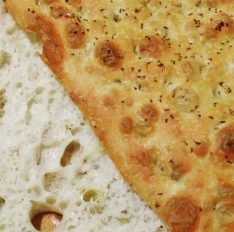
Wood Fired Foccaccia with Fennel Tops
Brixham Hake with Caper and Green Olive Sauce
We love hake – big white, sweet flakes from an underrated member of the cod family. Strange how we love it when in Spain and it’s called Merluza. There is a lot caught and landed in Brixham and our fishmongers manage to divert a little before it mainly heads abroad to greater appreciation. Fish is top of the list when people ask us what cooks best in the wood fired ovens – the high heat means it cooks quickly, steaming on the inside and charring on the outside, puffing up and staying moist. For our fish dish in Chiswick, we softened some shredded leeks in a big wide pan and added sundried tomatoes, white wine, capers, green olives and fresh tomatoes to create a sauce. Then small pieces of hake were poached in it – gently cooking in the protective sauce and getting grilled from above by the flames from the fire. No photo of the hake we cooked but here’s a plaice we cooked in a similar fashion for our next book – Wood Fired Fish & Seafood (of course!)
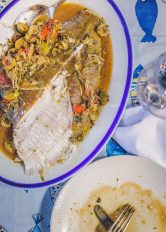
Whole Brixham Plaice cooked with leeks, capers and olives
Lamb Souvlaki
Grilled lamb skewers were next cooked over embers with flames licking over the top – we used shoulder from our friends in Dittisham up the river who have White Faced Dartmoor Sheep and keep them for hogget. Then we followed Rosie Barron’s recipe and marinated it overnight in lemon, white wine, garlic, oregano and oil.
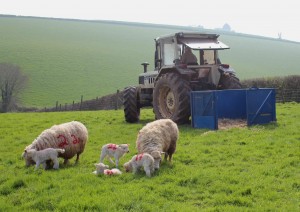
White Faced Dartmoor Sheep with their lambs in Dittisham
Totnes Oats with Beetroot Tops, Pumpkin Seeds and Feta
For this we had already cooked 500g of Totnes groats until tender – covered in mushroom stock and simmered gently for around 50 minutes. We get the oats from Grown in Totnes – they are creating a market for local oats, pulses and grains so that they are used for human and not animal consumption. Good for the growers, the consumers and the local economy. Do have a look at what they are up to.
We softened 2 sliced red onions in some olive oil in our Netherton Foundry Prospector pan and then added the groats to heat through. On the way to London we had “borrowed” some beetroot tops from our friends at the Deer Park Hotel in Honiton so they were chopped up and put through the oaty mixture to wilt; I love them as you get the bits of pinky red stalk and the dark green leaves. They feed the beetroot tops to their deer while the roots head to the chefs for the restaurant but I love to harvest some stalks and leaves straight from their walled garden when we are there. While all this was heating up, we toasted some pumpkin seeds in a small pan in the Morso to get some colour and boost their flavour. These were mixed through with some chopped parsley and small cubes of Feta cheese sprinkled over the top. Another drizzle of olive oil and you’ve got a great vegetarian main course or a side dish for the lamb.
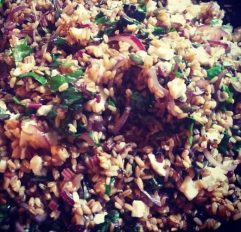
Totnes Oats with Beetroot Tops, Pumpkin Seeds and Feta
Raspberry and Hazelnut Empanadas
We like to cook something sweet in the wood fired ovens as people can assume they are just for high heat savoury cooking. With some management, you can stabilise the ovens to create great breads, cakes and pastries. These empanadas are fun to make for children and can be cooked in advance or baked with the oven still hot and served with some ice cream
We rolled out some ready-made flaky pastry and cut out discs about 8cm across. Then we mixed 100g cream cheese with 100g fresh raspberries and 30g toasted and chopped hazelnuts. Stir in the finely grated zest of 1 orange and you’ve got your filling for the empanadas. Put 1-2 teaspoonfuls of the filling on each disc and seal them together to make mini pasties. Brush with egg wash, put on a baking sheet and prick the tops. Bake in a moderate oven – 3 Mississippi – with the door shut until the empanadas are golden brown and the pastry is cooked through.
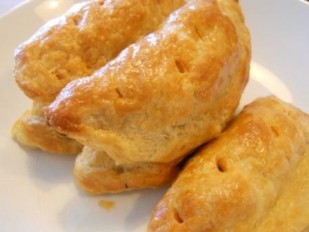
Empanadas with flaky pastry
It’s always great to get out and about and chat with people about what we do and show them how the wood fired ovens work – basically it’s just an oven and you can pretty much cook anything in them; that’s the complete joy of it all. It was equally stimulating to share our cooking with the food writers who were a great crowd – interested in seeing the ovens at work, eating the food and sharing their experiences of using them with us; isn’t that the joy of being with enthusiasts, that they fire you up (pardon the pun) in return.


